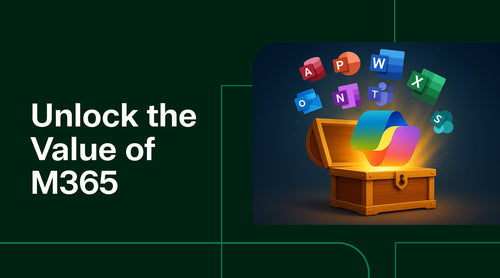ChatGPT is your chatty sidekick for curious conversations, while Copilot is GPT-4 in a power suit, ready to roll up its sleeves and get to work.
AI-powered assistants are transforming how we work, write, and collaborate. Two of the most discussed tools in this field are ChatGPT by OpenAI and Microsoft Copilot (an evolved form of OpenAI’s AI offering), integrated into Microsoft 365 apps. While both tools utilize similar underlying technology, they are designed for different use cases.
If you are unsure whether to invest in Copilot or stick with ChatGPT (free or paid), this guide explains the similarities, differences, pros and cons, and the free vs. paid options to help you make the right choice.
Same Brain, Different Jobs: How GPT-4 LLM Powers Both ChatGPT and Copilot
ChatGPT and Microsoft Copilot both use GPT-4, a super smart language model from OpenAI. It’s trained on a large amount of public data, which helps it get the gist of what you’re saying, respond in a way that feels natural, and help out with stuff like writing, coding, summarizing, or digging into information. While ChatGPT uses GPT-4 to power natural conversations and creative tasks, Copilot integrates the same underlying technology directly into Microsoft 365 apps like Excel, Teams, Exchange, Fabric, and SQL, turning everyday workflows into intelligent, AI-assisted, or even AI-driven experiences. Despite their different interfaces and use cases, both tools leverage GPT-4’s deep language understanding to make work and communication faster, smarter, and more intuitive.
Quick Feature Comparison Overview
| Feature | ChatGPT | Microsoft Copilot (M365 Copilot) |
|---|---|---|
| Developer | OpenAI | Microsoft (powered by OpenAI models) |
| Primary Use | General-purpose chatbot & assistant | Embedded productivity assistant for Microsoft 365 apps |
| Access Points | ChatGPT app, web | Microsoft Solutions Integration |
| Free Version | Yes (GPT-3.5) | Yes |
| Paid Version | Yes (GPT-4) | Yes ($30/user/month) |
What ChatGPT and Copilot Have in Common
Although they each have different developers, use cases, and methods of interacting and prompting, ChatGPT and Microsoft Copilot have a couple of key similarities:
- AI-Powered Assistance: Both are built on OpenAI’s GPT-4 model, providing natural language abilities that understand and respond to prompts in a conversational manner.
- Productivity Focus: These tools can create content, summarize documents, respond to questions, and automate repetitive tasks.
- Time-Saving Benefits: Whether you are drafting emails, analyzing data, or brainstorming ideas, both tools help streamline workflows.

Key Differences Between ChatGPT and Copilot
| Category | ChatGPT | Microsoft Copilot |
|---|---|---|
| Environment | Standalone app or browser | Embedded in Microsoft Solution Stack |
| Integration | Minimal (unless using APIs/plugins) | Deeply integrated in Devices, People, Data, and Security solutions for proper use |
| Data Access | Limited to user input and chat history | Has access to all data it has permission to access |
| Enterprise Controls | Not inherently enterprise-ready | Built with compliance, security, governance in mind |
| Customization | GPTs and API-based customization | Supports tenant-level customization via Microsoft Graph |
Use Cases: Who Benefits from Each Tool
ChatGPT Is Best For:
- Writers, marketers, developers, and students engaging in brainstorming, outlining, or creating content.
- Coding support and technical Q&A.
- Budget-conscious users seeking a free or affordable AI assistant.
Microsoft Copilot Is Best For:
- Microsoft 365 users and enterprise IT teams
- Develop business insights using new and historical data.
- Improve alignment by scheduling meetings and summarizing Teams conversations with accountability measures incorporated.
- Organizations seeking to boost functional impact by minimizing mundane tasks.
Free vs. Paid: What's the Difference?
ChatGPT
| Free Version (GPT-3.5) | Paid Version (GPT-4 / GPT-4o at $20/month) |
|---|---|
| No cost to use | Faster, smarter, and more accurate & more relevant |
| Slower, more limited reasoning | File uploads, image understanding, browsing, and plugins |
| Cannot access files, images, or browse the internet | Option to build custom GPTs with memory |
Microsoft Copilot
| Free Version | Paid Version (M365 subscription at $30/month) |
|---|---|
| No cost to use | AI embedded in Word, Excel, Outlook, PowerPoint, Teams |
| Limited usage; extends to multiple devices | Personalized responses based on your organization’s content |
| Access to core Copilot features like chat, content generation, and web search | Built-in security, compliance, and identity management |
| Cannot be used with M365 apps | Deep Research – Create comprehensive reports |
Pros and Cons of ChatGPT
ChatGPT’s biggest strength is its versatility; it can assist with everything from writing and brainstorming to coding and research, effectively acting as a personal assistant, tutor, and creative partner all in one. What makes it even more powerful is the LLM's ease of use. There is no need for an advanced degree in IT; in fact, it's quite the opposite. All you need is to know how to read and write. ChatGPT acts like an answer engine. Simply type in your question (prompt), and ChatGPT will provide a great answer. Need more details? Simply ask. This simple and effective tool can be used by practically anyone.
| ChatGPT Pros | ChatGPT Cons |
|---|---|
| Free to get started | No business data access without integrations |
| Flexible across industries and tasks | Misinformation due to lack of contextual relevance of outputs |
| User-friendly and widely available | Limited collaboration features |
| Great for brainstorming and learning | Not built for enterprise-grade security |
Pros and Cons of Microsoft Copilot
What makes Microsoft Copilot so powerful is how naturally it fits into the Microsoft 365 tools people already use every day, like Word, Excel, Outlook, and Teams. The great thing about Copilot is that it works alongside the tools you use every day. Since it’s built on GPT-4, it can handle many tasks that are time-consuming. Examples include drafting documents, crunching numbers, and forecasting data; the kind of repetitive and boring work that hinders our daily productivity. By using Copilot to manage these routine tasks, employees can focus on more impactful, value-adding assignments.
| Copilot Pros | Copilot Cons |
|---|---|
| Deep Microsoft 365 integration | Higher cost ($30/user/month) |
| Context-aware based on your emails, docs, and calendar | Only available in the Microsoft ecosystem |
| Enterprise-grade security and compliance | Readiness is a gap for most businesses |
| Time-saving for knowledge workers | Limited adoption support for full integration |
Final Verdict: Should You Use ChatGPT or Copilot?
It depends on your role, environment, and budget.
- If you are an individual creator, freelancer, or student, ChatGPT (especially the free or GPT-4 Version) provides you with powerful tools at a low cost.
- If you are part of an organization using Microsoft 365, Copilot is a no-brainer for seamlessly integrating AI into your daily workflows with enterprise-grade security and data context.
- In some cases, combining both tools offers the best of both worlds: general-purpose intelligence from ChatGPT and work-specific automation from Copilot.
Conclusion
Both ChatGPT and Microsoft Copilot harness the powerful GPT-4, yet they serve different purposes tailored to distinct needs. ChatGPT functions as a versatile, conversational AI perfect for creative exploration, learning, and flexible support, accessible to anyone at little or no cost. Meanwhile, Copilot integrates AI directly into Microsoft 365, transforming daily work tasks with seamless operation, contextual awareness, and enterprise-grade security, making it an essential productivity tool for businesses and knowledge workers. Ultimately, choosing between them or using both together depends on your role, workflow, and objectives. Together, they show how AI is reshaping the future of work and communication, providing smarter, faster, and more intuitive ways to get things done.















